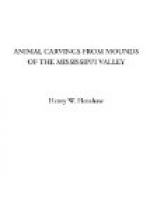[Illustration: Fig. 10.—Manatee (Manatus Americanus, Cuv.). Side view.]
[Illustration: Fig. 11.—Manatee (Manatus Americanus, Cuv.). Front view.]
There would seem, then, to be no escape from the conclusion that the animal sculptures which have passed current as manatees do not really resemble that animal, which is so extraordinary in all its aspects and so totally unlike any other of the animal creation as to render its identification in case it had really served as a subject for sculpture, easy and certain.
As the several sculptures bear a general likeness to each other and resemble with considerable closeness the otter, the well known fish-eating proclivities of this animal being shown in at least two of them, it seems highly probable that it is the otter that is rudely portrayed in all these sculptures.
The otter was a common resident of all the region occupied by the Mound-Builders, and must certainly have been well known to them. Moreover, the otter is one of the animals which figures largely in the mythology and folk-lore of the natives of America, and has been adopted in many tribes as their totem. Hence, this animal would seem to be a peculiarly apt subject for embodiment in sculptured form. It matters very little, however, whether these sculptures were intended as otters or not, the main point in the present connection being that they cannot have been intended as manatees.
Before leaving the subject of the manatee, attention may be called to a curious fact in connection with the Cincinnati Tablet, “of which a wood-cut is given in The Ancient Monuments” (p. 275, Fig. 195). If the reverse side as there shown be compared with the same view as presented by Short in The North Americans of Antiquity, p. 45, or in MacLean’s Mound-Builders, p. 107, a remarkable discrepancy between the two will be observed.
[Illustration: Fig. 12.—Cincinnati Tablet. (Back.) From Squire and Davis.]
In the former, near the top, is indicated what appears to be a shapeless depression, formless and unmeaning so far as its resemblance to any special object is concerned. The authors remark of this side of the tablet, “The back of the stone has three deep longitudinal grooves, and several depressions, evidently caused by rubbing,—probably produced in sharpening the instrument used, in the sculpture.” This explanation of the depressions would seem to be reasonable, although it has been disputed, and




